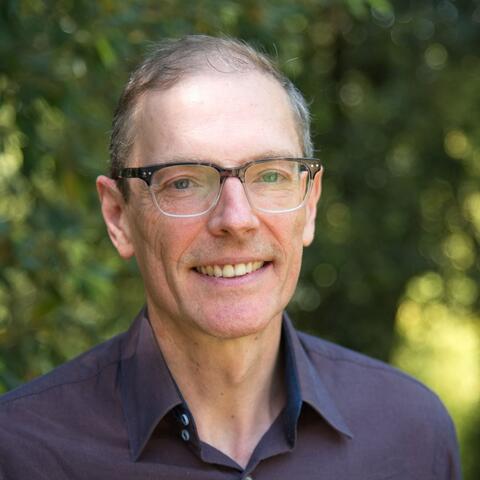Changing Vision
Catherine Hartmann investigates how Buddhists learn to see holy places correctly.

Catherine Hartmann was first exposed to Buddhism in a church Bible study group. “We were reading a book about other world religions and why they were wrong,” Hartmann says. According to the PhD candidate in the study of religion, the lessons from the book completely backfired. “I was very intrigued by the Buddhist beliefs about impermanence,” Hartmann explains. “I found it so compelling and fascinating, and it awoke in me the desire to learn more.”
This desire would take Hartmann to India, the birthplace of Buddhism, and down an academic path that would eventually lead her to Harvard and the Committee on the Study of Religion, where she studies the phenomenon of pilgrimage in Tibetan Buddhism.
Seeing is Believing
“One of the fundamental insights of Buddhism is that all suffering is the result of misperceiving how reality works,” explains Hartmann. She picks up a coffee cup to illustrate this idea. “I see this coffee and I want it to be permanent and hot. And when it’s gone and cold, I feel suffering. But it was never the case that the coffee was always going to be there and hot. Buddhism states that suffering occurs when we’re not seeing reality as it is.” Many of the practices of Buddhism push practitioners to see reality accurately. Meditation is probably the most famous of these practices though, according to Hartmann, historically most Buddhists have not meditated. “It was seen as a very elite practice for a very small number of monks,” she explains. The majority of Buddhists were involved in other practices such as generosity, image devotion, and pilgrimage.
In Islam, a pilgrimage to Mecca is considered mandatory for all Muslims who are financially and physically capable. In Buddhism, there is no equivalent to Mecca, but rather many different pilgrimage sites. “There is no centralized authority in Buddhism,” Hartmann says. “There is not a pope of Buddhism or one requisite pilgrimage.” Instead, as Buddhism spread from India, the pilgrimage sites mentioned in early Buddhist texts got recreated in these new places. “This re-mapping of pilgrimage locations allows you to see the place you are living as part of the Buddhist landscape,” says Hartmann.
I see pilgrimage as a lab for trying to change vision and pilgrimage guides can facilitate this transformative process.”
One such location is Mount Kailash. Hartmann explains that in Buddhist cosmology there’s a triangle-shaped continent that we all live on. Towards the top of this continent is a big mountain that’s the center of the Earth, which in Indian Buddhist scriptural texts is called Kailash and spoken of as the mountain in the north. “It is a metaphor for this northern, hard-to-get-to place that only very serious yogis traveled to,” Hartmann says. “Interestingly, when Buddhism moves from India into Tibet, the Tibetans say ‘well, we’re in the North. Is it that mountain?' ” Hartmann explains. In Indian Buddhist tradition, the mountain in the north had been a metaphor of purity, but in Tibet this pilgrimage gets concretized around one specific mountain—Mount Tise, also called Mount Kailash.
A Lonely Planet for Holy Sites
Mount Tise is a striking, pyramidal peak in what is known as the Kailash range, located in the Tibet Autonomous Region of China. It is also near the watershed of many major rivers in Asia, such as the Indus and the Ganges. When Tibetans were looking for Kailash, Mount Tise seemed like the obvious choice. “Of course, a debate immediately breaks out over whether this mountain is or is not the exact mountain that is discussed in Buddhist literature,” says Hartmann.
The Tibetan scholar Sakya Pandita (1182–1251) was one of the naysayers. “He says, ‘I went there. I didn’t see elephants. I didn’t see rose apple trees. This is the wrong mountain and pilgrimage here is a waste of time’,” Hartmann describes. The scholars opposing Sakya Pandita accused him of having deluded vision. “This debate gets into the actual questions of my dissertation, which is what you are supposed to see when you look at a holy place and how you can learn to see it correctly,” explains Hartmann.
To explore these questions, Hartmann studies pilgrimage guides from the 13th to 17th century. “Just as when I go to a different country and bring a Lonely Planet guide, there are pilgrimage guides that tell you about the site you’re visiting,” Hartmann explains. The guides will point out the handprint left by a famous master, a cave where a hero defeated an evil magician, or a mountain that is actually a sacred palace.
“These pilgrimage texts know full well that you’re mostly seeing rocks,” Hartmann says. “They have their own theorization as to why most people don’t see a sacred palace.” Someone with perfected vision like the Buddha or an advanced practitioner, they claim, would have looked at these same rocks and seen a palace. For Hartmann, one of the most interesting aspects of her work is exploring what the pilgrims felt when they struggled to see a palace and how the guidebooks could help them see it. “It’s like a Magic Eye book. If you turn it sideways or squint, you can almost see it for a moment,” she describes.
“Vision is a strange thing,” says Hartmann. “We think of it as just a physiological process, but how we see the world is influenced by our ideas, our backgrounds, even texts like these pilgrimage guides.” According to Hartmann, the language in the pilgrimage guides paints this beautiful picture of the thing you’re seeing and helps pilgrims almost capture the sacred palace they long to see. “I see pilgrimage as a lab for trying to change vision and guides can facilitate this transformative process.”
Photo by Molly Akin
Get the Latest Updates
Join Our Newsletter
Subscribe to Colloquy Podcast
Simplecast




